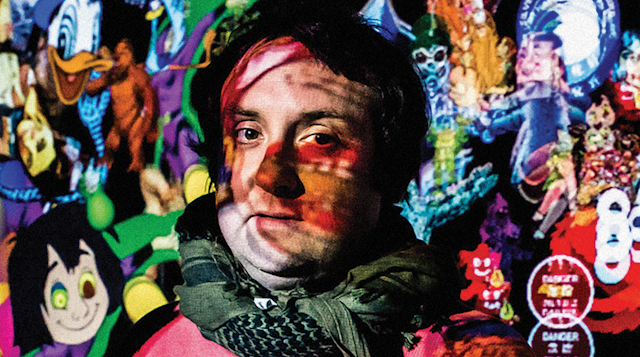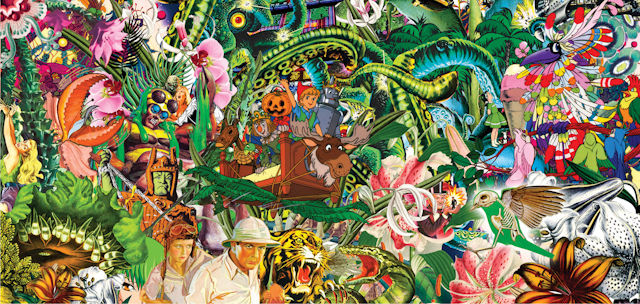
Advertisement

Mojoko / Mojoko
The Drum catches up with multimedia artist Mojoko, who says step away from the sterilized sheen of Singapore’s center and you’ll find it a lot more creative than people give it credit for.
Ask what Singapore is like and anyone who doesn’t live there, and a few who do, will reply with adjectives such as ‘clean’ or ‘safe’. Rarely will their description include words such as ‘creativity’ or ‘subcultures’, but scratch below the surface of its immaculate sheen and take a trip away from the towering blocks of steel in its central business district and you will find a vibrant underground of creative talent.
Steve Lawler has been championing this side of Singapore for more than a decade. Better known by the moniker Mojoko, the multimedia artist is looking to take on the naysayers and tells The Drum that it is time for Singapore to take creativity into a more mainstream way of thinking.

“I would like to go head to head with anyone accusing Singapore of not being creative. I’d like to challenge them, see what they mean and prove it wrong. It is flowering,” he says.
“From a very traditional ad industry it has splintered into something much more fun. There was never a graphic design industry here before, or a tech industry. And the illustration scene is really growing, too.”
Lawler’s own creative career follows a similar path to Singapore’s. Born in Iran and raised in Hong Kong, he received a creative education at Fabrica in Italy before eventually moving to Singapore and into digital creative work at Ogilvy, a bastion of the traditional advertising space.
From here he started to get involved with Singaporean subcultures, discovering a creative underbelly firstly in street art and then in its drum-and-bass scene. This led to the creation of Kult – a magazine-cum-creative agency-cum-art space-cum-curator – and a successful standalone career as an artist.
“Creativity is not a main characteristic of the Singaporean population, but it is there in terms of experimentation and pioneering with technology and design, and maybe in advertising to an extent. There is ability within the agencies and the hot little creative shops: they ooze world-class creativity. Primarily this is because of Singapore’s multicultural landscape. Ideas happen from bringing together different parties and perspectives and I think those metropolises are the hotbed for ideas and creativity.”
With all the ingredients in place for Singapore to be a creative leader, the truth remains that this isn’t a common perception of the state. Lawler says that its conservative foundations don’t help, but it is clear from walking around the city that design is taken seriously.

“Being a conservative society gives people extreme conceptions about the place, but everywhere is fun and interesting and exciting to an outsider.
“Design here is solid, and Singapore is a design linchpin for the region because it’s international, it is English-speaking (not that it matters, you can go to Taipei and see some amazing graphic design – that is the nature of good design). If you look around in Singapore at the food, the beverages, the hotels... they know they need to have a good design game to even be noticed. It’s a staple and it’s expected. That alone can sustain a creative industry.”
Sustainability is a key word for creativity because Singapore’s domestic scale is so small. Many international agencies that set up shop here struggle to make the revenues to survive unless they win regional business. Smaller shops, collectives and freelancers can flourish, but it’s not easy and Lawler says contributing to the creative community and culture helps build a solid foundation.
“For independents, it’s not so much becoming hard, but rather it has always been hard. What is really hard though is if you are an international but small outfit – you’re not going to stand a chance.
“A lot of the creative companies in Singapore are good small shops and they’ve been around for years. It’s not like there are a lot of new agencies now, they’ve been grinding away for years.
“Success stories now come from the likes of Asylum and Kinetic, the art and design-led agencies. Whether they do corporate communications or mainstream advertising, they all come from a design background and I think that is why they are successful – they contribute to culture.”
The leap to scale for international business is, on one hand, easy because Singapore is so well set up and connected to the region. But on the other hand, costs mount up and it can be hard for independents to move beyond domestic work.

“If you want to go for international business you need savvy client-service people, which is expensive and the overheads start to build up. If you are pitching left, right and center for every piece of work and not getting it, you start getting really desperate. You start cutting costs and fees and that price war affects everybody. I don’t know how long these kinds of ideas can be sustainable.”
The independent agency scene in Singapore is, therefore, a lot of smaller hot shops that service three or four regular clients. It means they are afforded trust and loyalty, and as a result can try bolder ideas.
Creating a balanced creative environment in which more creative businesses can flourish hinges on raising the profile of the industry and the companies within it, says Lawler. A common problem for independent agencies worldwide is having the resources to maintain a high profile while remaining interesting to the press and wider industry, something networks have become very good at.
“What is hard for the smaller shops is to stay relevant and be in the news year after year. Usually you get in the spotlight for two or three years and then people don’t want to write about you any more.”
He adds that small agencies can have difficulty attracting talent because of this. “They may be doing nice work but their names aren’t mainstream. They need to do work that is celebrated by the mainstream public and interact with the public-facing part of the scene.”
This is why Kult, with its core business in connecting brands to Southeast Asian artists, developed the magazine and gallery alongside – to not only document the work or the artists but also to gain a network effect.
“We knew we would be going up against some of the big guys and that we would never be able to be as big or as strong as them, so we had to make ourselves famous,” Lawler says. “We created a public-facing company in the gallery, the merchandise etc. I’d like to think we now have a good name around the Singapore mainstream audience and we achieved what we set out to do. We now get invited to pitch and are on tenders.”
With homegrown agencies gaining mainstream fame, the reputation of Singapore as a creative hub will surely lift and the indie scene will thrive. Next for Lawler is to use that to instill a wider appreciation of creative thinking within society.
“We need to get people to appreciate creativity and work out how they can harness it for their own benefits. Whether it’s institutions, schools, companies or startups, you can’t base your company on one big idea. You have to cultivate the idea of non-stop creativity.”
The Geylang-based full-service agency has been responsible for some of the most high-profile design launches in Singapore in recent years. It counts Singapore’s National Gallery and cosmetics brand Aesop among its clients, and launched stylish hotel The Warehouse last year.
Kinetic has earned itself global recognition to the tune of more than 500 awards, yet it still resides out of town in Joo Chiat, one of Singapore’s more fashionable neighborhoods on the east coast. As well as client work, the company set up the K+ Curatorial Space in 2015, an art gallery that it describes as a ‘retail-cum-community space’.
Foreign Policy labels itself as a design bureau and think tank and counts some of Singapore’s best-known local brands as clients. From co-working spaces such as the Working Capitol to hipster food favorites Super Loco and MeatSmith, the agency has put its stamp on many of Singapore’s modern design heroes.
Lifestyle brand specialist Division Comms edges more into the events and experiential space. Launched over 10 years ago, the agency has worked with major brands such as LV, Burberry, Chanel and Loewe. Activity varies from catwalks to private launches to music festivals.
Creative pair Fizah & Ando make up Machine East, specializing in 3D illustration, art direction, design and typography. As well as creating art using motion graphics, the pair have created work for brands including Nike, Uniqlo and Guinness.
Lawler will be speaking at a a breakfast event next week in Singapore which aims to look at the future of Singapore's creativity. To attend, sign up here.
This feature is from the Singapore installment of The Drum's Creative Cities series, which is sponsored by The Trade Desk and published alongside our September issue of the magazine. Become a member of The Drum+ to get your hands on a copy.